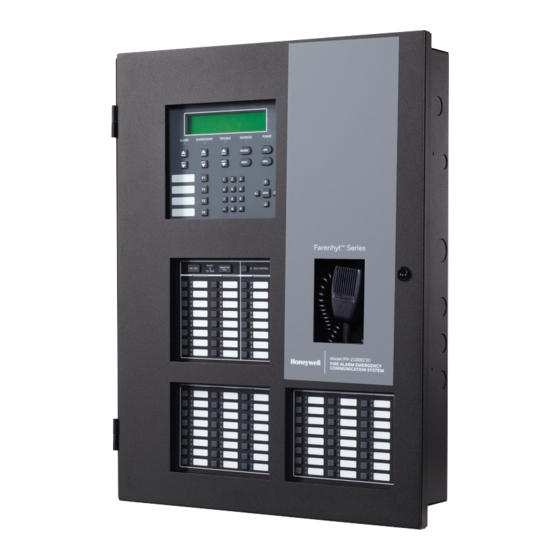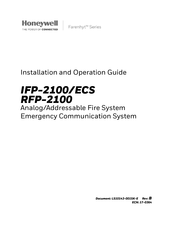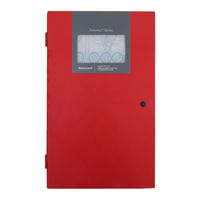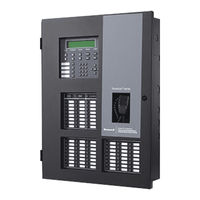
Honeywell IFP-2100ECS Fire Alarm Panel Manuals
Manuals and User Guides for Honeywell IFP-2100ECS Fire Alarm Panel. We have 4 Honeywell IFP-2100ECS Fire Alarm Panel manuals available for free PDF download: Installation And Operation Manual, Manual, Basic Operating Instructions
Honeywell IFP-2100ECS Installation And Operation Manual (265 pages)
Analog/Addressable Fire System
Emergency Communication System
Brand: Honeywell
|
Category: Conference System
|
Size: 4.89 MB
Table of Contents
-
Section 1
14 -
Introduction
14 -
Section 2
19 -
-
Section 3
24 -
-
Inventory24
-
-
-
Section 4
43 -
-
SBUS Wiring48
-
-
-
-
LED Wiring70
-
-
-
-
Section 5
88 -
Section 6
98 -
-
-
Ping Panel98
-
-
-
Access Codes100
-
Edit Access Code101
-
Edit Name101
-
Panel Functions101
-
Voice Options103
-
-
Section 7
110 -
-
Section 8
120 -
-
Mapping Overview123
-
Event Mapping126
-
Section 9
144-
-
Edit Modules145
-
Naming Modules145
-
Adding a Module146
-
View Module List146
-
View Zone Points150
-
-
System Options164
-
-
Auto Test Time164
-
Dialing Prefix165
-
Phone Lines165
-
Dial Format166
-
Monitor Line166
-
Alarmnet Timers167
-
Edit Ethernet167
-
Phone Line Gains168
-
-
Holiday Days169
-
Time Options169
-
Edit Banner172
-
SLC Family172
-
-
Restore Defaults173
-
Voice Options173
-
VCM Maintenance174
-
Voice Settings174
-
-
-
Section 10
175 -
System Operation
175-
-
Banner176
-
LCD Display176
-
Menu System176
-
Basic Operation177
-
Using the Menus177
-
Reset Alarms180
-
Event Priority183
-
System Control183
-
System Override183
-
Priority Rules184
-
-
-
Function Keys192
-
Section 11
194 -
-
Overview194
-
-
ECS Control Key194
-
Keys and Leds194
-
ECS Control LED195
-
ECS Message Keys195
-
ECS Message Leds195
-
Select Key Leds195
-
-
-
LOC Lockout196
-
LOC Priority196
-
-
Manual ECS197
-
Microphone Mode198
-
Message Mode198
-
Custom ECS Event198
-
-
ECS Super User199
-
ECS Reset199
-
LOC Programming201
-
Adding an LOC201
-
-
Editing an LOC202
-
-
LOC Association202
-
LOC Priority202
-
-
Fire Page203
-
Emergency Page203
-
Paging203
-
-
Custom ECS Event203
-
-
Network Paging209
-
Priority209
-
Configuration210
-
-
-
Section 12
211 -
Reporting
211 -
Section 13
226 -
Section 14
231 -
-
-
Character Table249
-
Cadence Patterns251
-
Panel Security253
-
ECS Front View259
-
LED Conditions259
Advertisement
Honeywell IFP-2100ECS Manual (176 pages)
Addressable Fire Alarm Control Panel
Brand: Honeywell
|
Category: Fire Alarms
|
Size: 2.89 MB
Table of Contents
-
Inventory17
-
Board Layout31
-
2: Wiring67
-
Modules95
-
Zone97
-
1: Edit Zone97
-
Group100
-
1: Edit Group100
-
Point101
-
System Options111
-
3: Holiday Days114
-
4: Time Options114
-
7: Edit Banner116
-
8: SLC Family117
-
Restore Defaults117
-
Voice Options117
-
1: LCD Display119
-
2: Banner119
-
Menu System120
-
Basic Operation122
-
10: Reset Alarms124
-
Event Priority126
-
Function Keys132
-
Overview134
-
1: Keys and Leds134
-
3: Manual ECS135
-
4: Fire136
-
5: Message Mode136
-
10: ECS Reset138
-
ECS Super User138
-
LOC Programming139
-
1: Adding an LOC139
-
3: Fire Page140
-
5: Paging140
-
Network Paging144
-
1: Priority144
-
2: Configuration144
-
Troubleshooting156
-
Event History157
-
ECS Control173
Honeywell IFP-2100ECS Installation And Operation Manual (98 pages)
Emergency Communication System
Brand: Honeywell
|
Category: Conference System
|
Size: 2.72 MB
Table of Contents
-
Overview8
-
Features9
-
Installation14
-
VBUS Wiring43
-
SBUS Wiring45
-
VBUS Wiring52
-
Class B60
-
Class a61
-
VBUS Wiring61
-
SBUS Wiring63
-
VBUS Wiring73
-
SBUS Wiring76
-
Sw1 - Amp a79
-
Sw2 - Amp B79
Advertisement
Honeywell IFP-2100ECS Basic Operating Instructions (5 pages)
Brand: Honeywell
|
Category: Control Panel
|
Size: 0.61 MB



